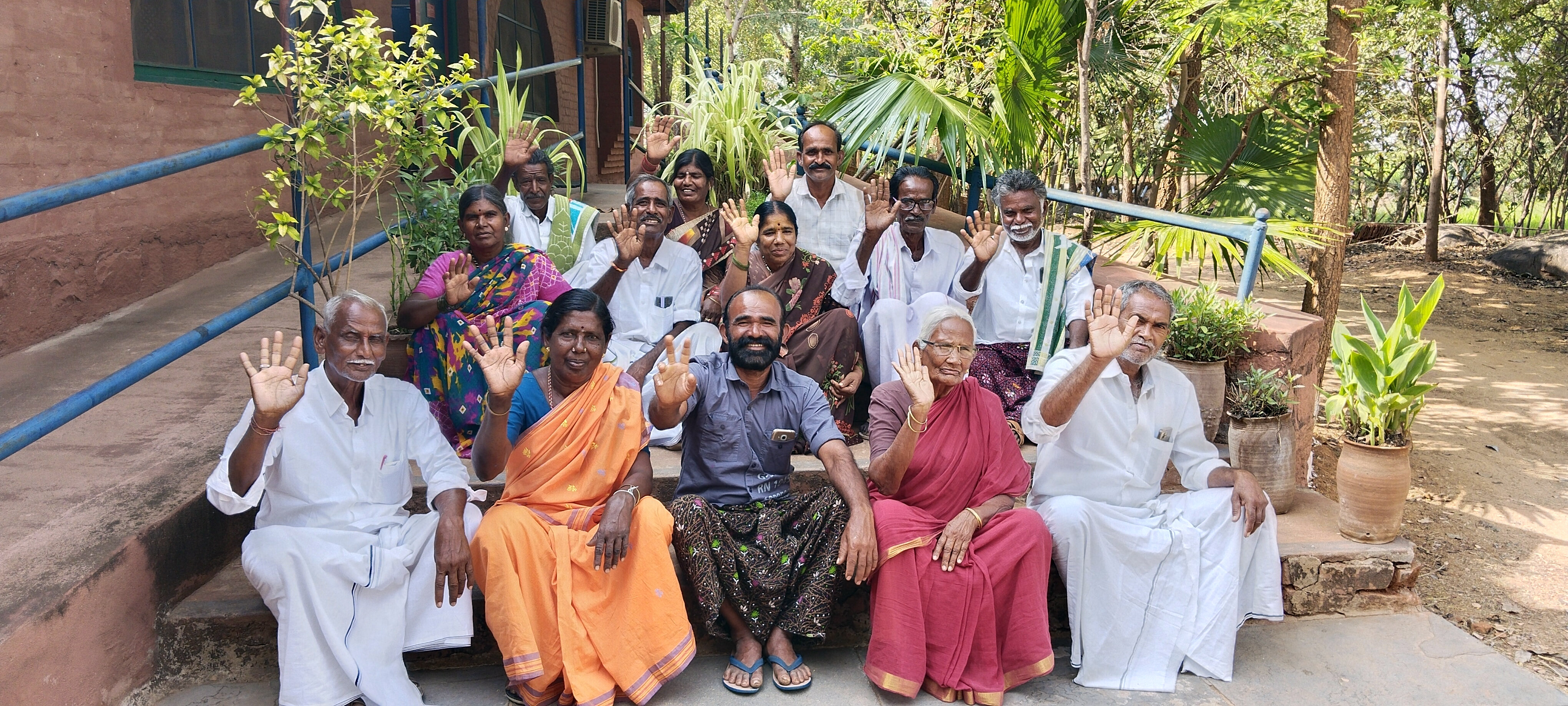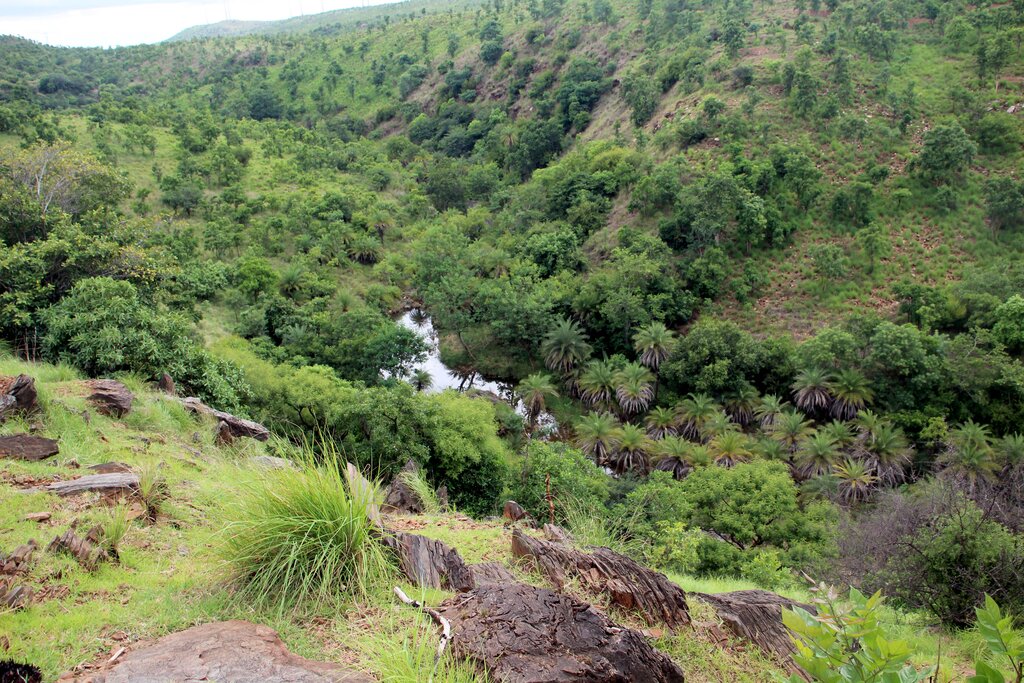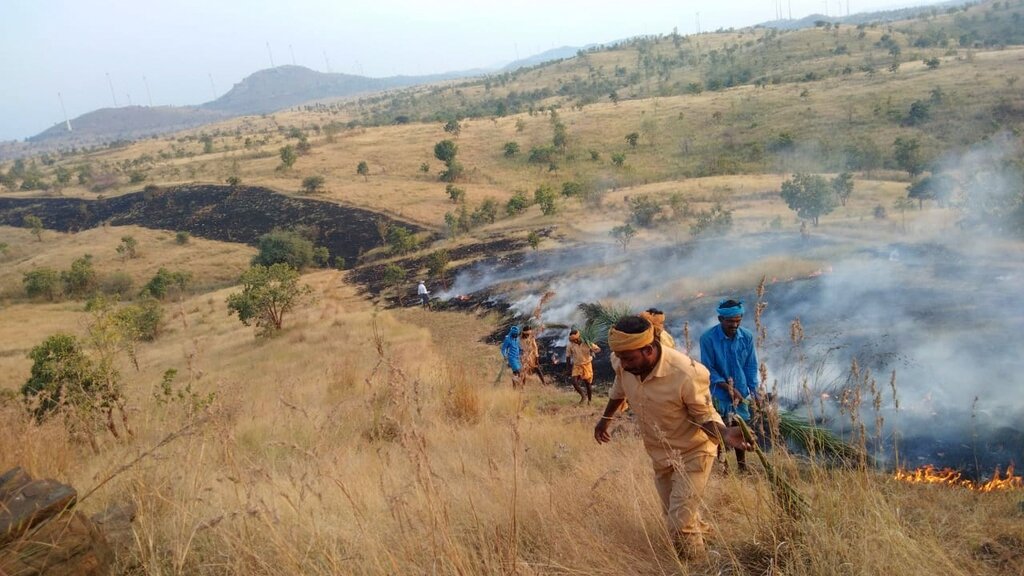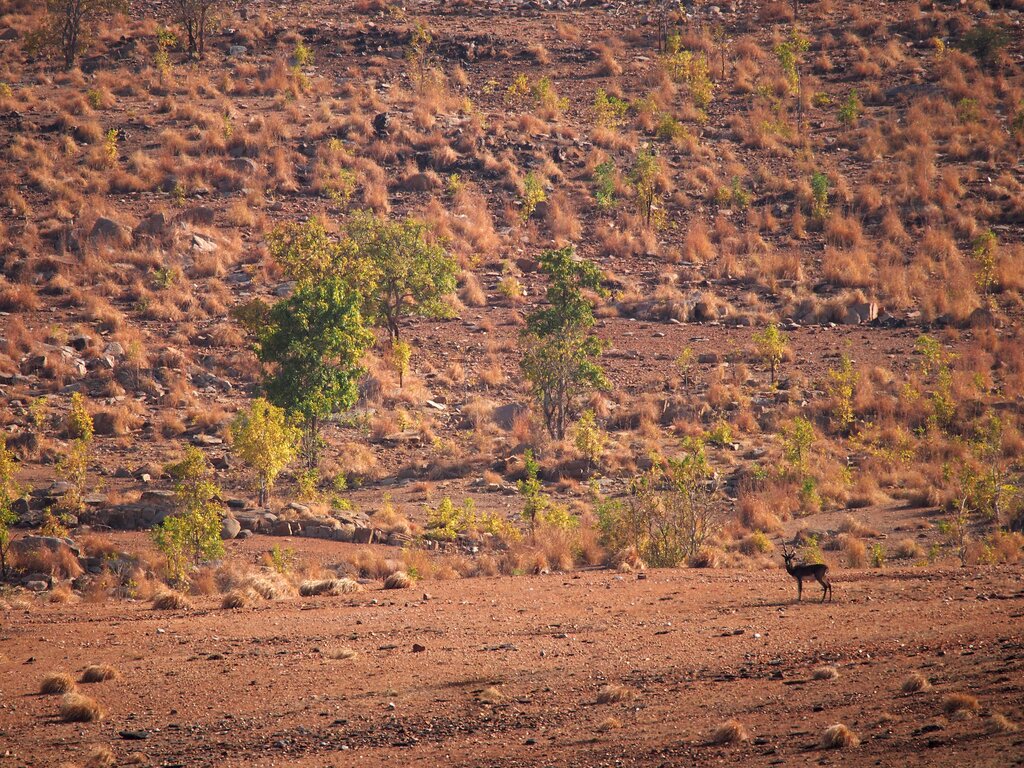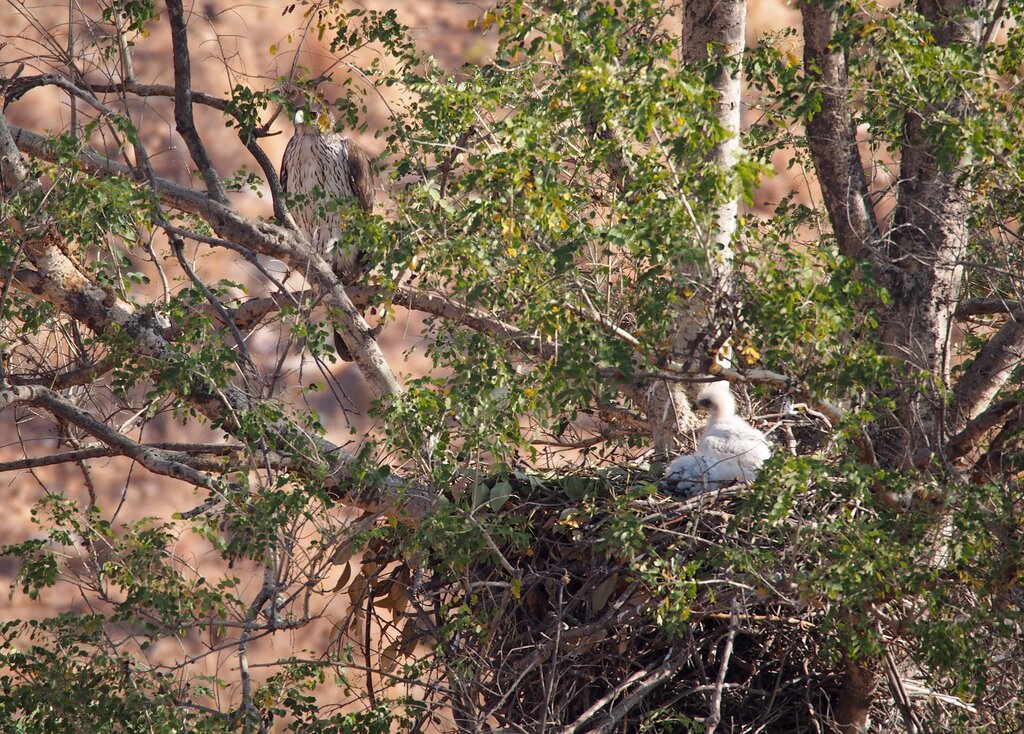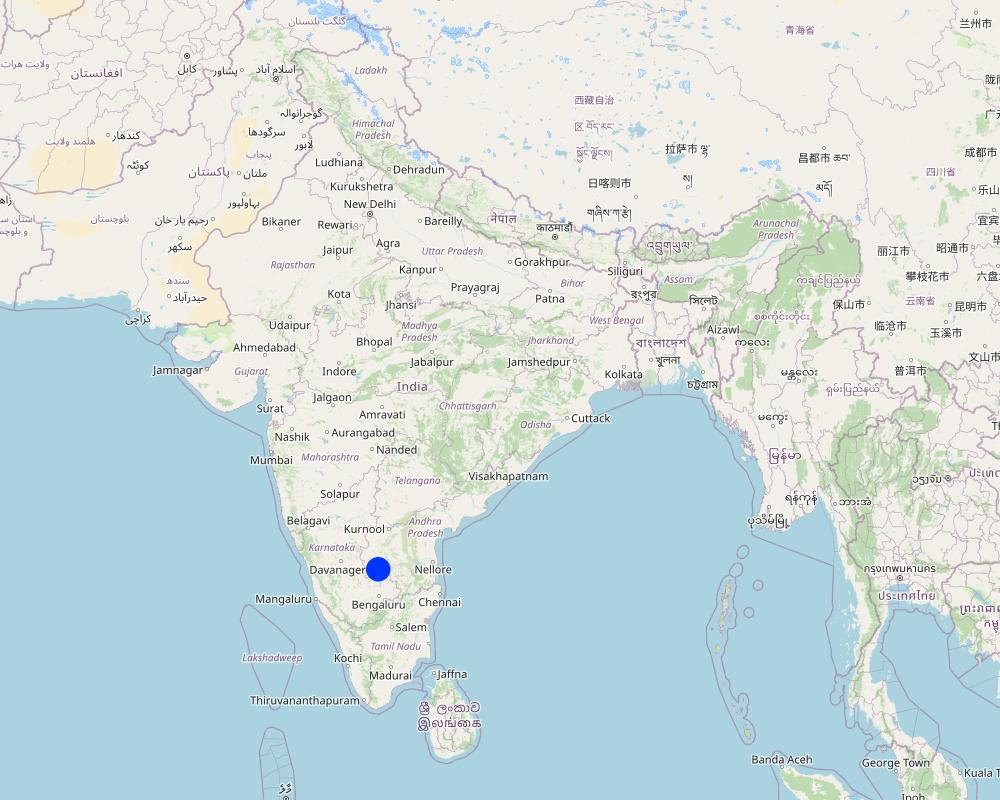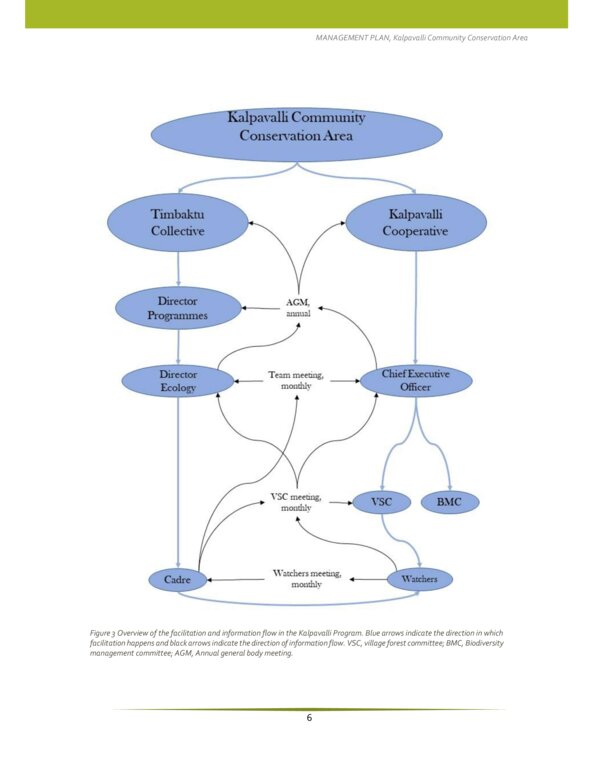Kalpavalli conservation approach: community-centred conservation of the commons [ອິນເດຍ]
- ການສ້າງ:
- ປັບປູງ:
- ຜູ້ສັງລວມຂໍ້ມູນ: Manisha Kairaly
- ບັນນາທິການ: Nicole Harari
- ຜູ້ທົບທວນຄືນ: William Critchley, Joana Eichenberger
Kalpavalli
approaches_6931 - ອິນເດຍ
ເບິ່ງພາກສ່ວນ
ຂະຫຍາຍທັງໝົດ ຍຸບທັງໝົດ1. ຂໍ້ມູນທົ່ວໄປ
1.2 ລາຍລະອຽດ ການຕິດຕໍ່ ຂອງບຸກຄົນທີ່ຊັບພະຍາກອນ ແລະ ສະຖາບັນ ການມີສ່ວນຮ່ວມ ໃນການປະເມີນຜົນ ແລະ ເອກະສານ ຂອງວິທີທາງ
ຜູ້ຊ່ຽວຊານ ດ້ານການຄຸ້ມຄອງ ທີ່ດິນແບບຍືນຍົງ:
Ganguly Choitresh
bablu@timbaktu.org
Timbaktu Collective
ອິນເດຍ
ຜູ້ຊ່ຽວຊານ ດ້ານການຄຸ້ມຄອງ ທີ່ດິນແບບຍືນຍົງ:
Vattamattam Mary
mary@timbaktu.org
Timbaktu Collective
ອິນເດຍ
co-compiler:
Rao Siddharth
sidsrao@gmail.com
Adavi Trust
ອິນເດຍ
ຊື່ຂອງໂຄງການ ທີ່ອໍານວຍຄວາມສະດວກ ໃນການສ້າງເອກກະສານ ຫຼື ປະເມີນດ້ານແນວທາງ (ຖ້າກ່ຽວຂ້ອງ)
G20 Global Land Initiative (GLI) Course (GLI Course)ຊື່ຂອງ ສະຖາບັນການຈັດຕັ້ງ ທີ່ອໍານວຍຄວາມສະດວກ ໃນການສ້າງເອກກະສານ ຫຼື ປະເມີນແນວທາງ (ຖ້າກ່ຽວຂ້ອງ)
G20 Global Land Initiative (GLI)ຊື່ຂອງ ສະຖາບັນການຈັດຕັ້ງ ທີ່ອໍານວຍຄວາມສະດວກ ໃນການສ້າງເອກກະສານ ຫຼື ປະເມີນແນວທາງ (ຖ້າກ່ຽວຂ້ອງ)
Arugu (Arugu) - ອິນເດຍຊື່ຂອງ ສະຖາບັນການຈັດຕັ້ງ ທີ່ອໍານວຍຄວາມສະດວກ ໃນການສ້າງເອກກະສານ ຫຼື ປະເມີນແນວທາງ (ຖ້າກ່ຽວຂ້ອງ)
Adavi Trust (Adavi Trust) - ອິນເດຍ1.3 ເງື່ອນໄຂ ຂອງການນໍາໃຊ້ເອກກະສານຂໍ້ມູນ ຂອງ WOCAT
ເມື່ອໃດທີ່ໄດ້ສັງລວມຂໍ້ມູນ (ຢູ່ພາກສະໜາມ)?
06/09/2023
ຜູ້ສັງລວມ ແລະ ບັນດາຜູ້ຕອບແບບສອບຖາມ ຍອມຮັບໃນເງື່ອນໄຂ ການນໍາໃຊ້ຂໍ້ມູນເອກະສານ ທີ່ສ້າງຂື້ນ ໂດຍຜ່ານ ອົງການ WOCAT:
ແມ່ນ
2. ພັນລະນາ ແນວທາງການຄຸ້ມຄອງນໍາໃຊ້ດິນແບບຍືນຍົງ
2.1 ການອະທິບາຍ ໂດຍຫຍໍ້ ຂອງວິທີທາງ
The Kalpavalli Community Conservation Area (KCCA) is a 6,500-acre (2,630 hectare) expanse of community-regenerated arid land located in the state of Andhra Pradesh in southern India. Over thirty years, participatory efforts have protected and restored this savannah ecosystem, with direct and indirect benefits to the community. This community-centred conservation of the commons is termed the Kalpavalli conservation approach.
2.2 ການອະທິບາຍ ລາຍລະອຽດ ຂອງວິທີທາງ
ການອະທິບາຍ ລາຍລະອຽດ ຂອງວິທີທາງ:
The Kalpavalli conservation approach is renowned for its focus on restoring common lands through the efforts of a cooperative society based on a federation of village forest committees. Community members are the beneficiaries. Through this approach, 6,500-acres (2,630 hectare) of arid and severely degraded common lands, have been successfully rejuvenated over the past 33 years. An NGO, Timbaktu Collective, has facilitated the conceptualisation and implementation of the approach.
The primary stakeholders are marginalized community members, including Dalits (the socially disadvantaged lowest castes), who have traditionally been landless labourers and pastoralists. Timbaktu Collective has played a critical role in community mobilization, capacity-building, training, and documentation. The approach empowered the lower castes to participate actively in the decision-making process and enabled them to advocate for benefits from government programmes. However, the lack of absolute ownership of the common lands and the potential influence of private parties with vested interests remain challenges.
The programme offers social and technical support. Details of the approach and its key focusses are as follows:
1. Social
Livelihoods: The Kalpavalli area is officially designated by the government as "wastelands", a contentious term which is applied to lands which the government does not consider economically productive. These lands are technically administrated by the State Government, but in most cases are either ignored or given to companies to establish factories or industrial estates. However, the Kalpavalli conservation approach ensures that traditional grazing and usage rights by communities are recognised. This facilitates sustainable land use centred on grazing, harvesting of non-timber forest produce, and more. The approach further promotes community management of common resources, joint responsibility for land protection, access to income generation from minor forest produce – all based on sustainable resource management.
Ownership and rights to resources: Grazing lands are largely under the technical ownership of the government, where traditional usage rights are permitted but not awarded legal status. The main challenge here is uncertainty about long-term ownership and rights to access. The approach therefore aims to secure usage, control, and ownership rights for the local community users. This is enabled through the creation of a community cooperative. The NGO and the cooperative have together been exploring various legal options to secure community ownership of the land.
Participation: The approach relies on social and technical methods, emphasizing community engagement. Social techniques include street theatre, community outings, participatory discussions, and voluntary service (“Shramadhanam”) to educate and mobilize the largely illiterate population.
Membership and monitoring: Members contribute an annual fee to access grazing and fuelwood collection. The approach includes policies for both protecting and monitoring common resources.
Organization development: Capacity-building, conflict resolution and organization management are facilitated through training and workshops.
Enterprise development: The community cooperative has launched eco-tourism initiatives to generate income, reinvesting profits into conservation efforts.
2. Technical
Restoration: The initial focus was on land protection, as common lands were degraded. In the initial years a key focus was on planting but then restoration work was modified as the land responded. Efforts have included protection from logging, creating firebreak lines, seed collection of native species, stream clearing, rotational grazing management, constructing rock-filled dams - and other watershed development work.
Protection of the commons: Stones were used to demarcate the land, and volunteer groups ("Vana Samrakshana Samithi") were established to prevent overgrazing and protect the area from uncontrolled fires.
Earthworks: Soil and water conservation measures such as rock-filled dams and earth bunds were introduced to reduce soil erosion and enhance groundwater recharge.
Research and management plans: Researchers helped map and share understanding of biodiversity. Biodiversity conservation, including both flora and fauna became a focus, with savannah ecology management plans developed.
Trees and vegetation: Initial attempts at using nurseries for propagation met with little success - and were replaced by seed broadcasting and propagation of local wild species. Seed huts were built to store seeds gather from this indigenous vegetation.
2.3 ຮູບພາບຂອງແນວທາງ
2.4 ວີດີໂອ ຂອງວິທີທາງ
ຄວາມຄິດເຫັນ, ຄໍາອະທິບາຍຫຍໍ້:
https://www.youtube.com/watch?v=J-VtU46p9KA
short video on the Kalpavalli Project
ຊື່ຂອງຜູ້ຖ່າຍວີດີໂອ:
Black Ticket Films
ຄວາມຄິດເຫັນ, ຄໍາອະທິບາຍຫຍໍ້:
https://www.youtube.com/watch?v=JZse_6PrGKg
About the conservation education work by the Timabktu Collective at the Kalpavalli Conservation Area
ຊື່ຂອງຜູ້ຖ່າຍວີດີໂອ:
Timbaktu Collective
ຄວາມຄິດເຫັນ, ຄໍາອະທິບາຍຫຍໍ້:
https://www.youtube.com/watch?v=l7s4VIqtpLA
A short video on the wildlife conservation work at the Kalpavalli Conservation Area
2.5 ປະເທດ / ເຂດ / ສະຖານທີ່ບ່ອນທີ່ແນວທາງໄດ້ຖືກນໍາໃຊ້
ປະເທດ:
ອິນເດຍ
ພາກພື້ນ / ລັດ / ແຂວງ:
Andhra Pradesh
ຂໍ້ມູນເພີ່ມເຕີມຂອງສະຖານທີ່:
Anatapuram District
Map
×2.6 ວັນທີເລີ່ມຕົ້ນ ແລະ ສິ້ນສຸດ ການຈັດຕັ້ງປະຕີບັດ ວິທີທາງ
ສະແດງປີຂອງການເລີ່ມຕົ້ນ:
1992
ຄວາມຄິດເຫັນ:
Ongoing
2.7 ປະເພດຂອງແນວທາງ
- Mixed using all three of the above
2.8 ເປົ້າໝາຍ / ຈຸດປະສົງຫຼັກ ຂອງການຈັດຕັ້ງປະຕິບັດ ວິທີທາງ
Water and Soil Conservation
Community-Led Conservation
Common Land Protection
Wildlife Conservation
Livelihood Generation
Empowerment of Local Communities
2.9 ເງື່ອນໄຂອໍານວຍ ຫຼື ຂັດຂວາງການປະຕິບັດຂອງເຕັກໂນໂລຢີ / ເຕັກໂນໂລຢີການນໍາໃຊ້ຕາມແນວທາງ
ສັງຄົມ / ວັດທະນະທໍາ / ມາດຕະຖານ ແລະ ຄຸນຄ່າທາງສາສະໜາ
- ອໍານວຍ
Cultural practises such as sramadhanam (volunteering physical labour for a common goal), vanabhojanam (feasts in the forest), Sacred Groves, Kattubaatu (group decisions and social agreements that everyone decides to honour)
- ເຊື່ອງຊ້ອນ
Lack of agency for women, caste system
ມີຄວາມສາມາດ / ເຂັ້າເຖິງຊັບພະຍາກອນດ້ານການເງິນ ແລະ ການບໍລິການ
- ອໍານວຍ
The most important factor to note, especially as a resource, was the Timbaktu campus serving as an active ecology lab. A lot of knowledge was transferred from this site to the hills of Kalpavalli. All the technologies implemented were done with locally available skills, labour and materials. Therefore, the costs were minimal.
- ເຊື່ອງຊ້ອນ
Initially it was difficult for the members to raise capital/ group savings by themselves. In light of this, the NGO fundraised small amounts to help the works undertaken, especially for wages and salaries of members. Additionally, being a low priority landscape, (these swathes of land are even called ‘wastelands’) it was difficult to raise large amounts for restoration works as it did not at that time capture the imagination of the population nor the Government.
ການກໍ່ຕັ້ງສະຖາບັນ
- ອໍານວຍ
The different technologies of the watershed concept such as gully plugs, greening, conservation, rock filled dams water flow delay and absorption were modified and adapted to this particular landscape thanks to having an institutional setting and back up. It served as an interface to acquire the knowledge and then systematically implement it on the field.
Having the institutional setting also allowed for the technological interventions to be suggested to the Government bodies for watershed works. It also worked in the favour of the approach that institutionally as well, these were not only ideas or concepts shared but were also actively being worked on in the field, which added to its credibility.
ການຮ່ວມມື / ການປະສານງານຂອງຜູ້ກ່ຽວຂ້ອງ
- ອໍານວຍ
The Community members (Forest Protection Committee) , the NGO, the Village level Panchayat, local Universities and the Government were all involved in these processes. If any of these actors did not cooperate then this approach would not have been possible. The larger goal of communities working towards ‘ greening’ was what largely aided this collaboration between various actors to occur
ກ່ຽວກັບກົດໝາຍ (ສິດນໍາໃຊ້ດິນ, ສິດນໍາໃຊ້ນໍ້າ)
- ອໍານວຍ
The concept of ‘land use for the commons’, village common lands.
- ເຊື່ອງຊ້ອນ
Technically the land belongs to the Government. So even if the community actively works and restores it, even for 3 decades, the ownership will not rest with them. Here are a few examples in how this has proved to a hindrance so far:
Land grab by private windmill companies
Green tribunal windmill case, though won, did not get payment to the community
Government granted sections of land to the Forest Department in the conservation area.
Electricity Department granted area to lay high power cables through wolf and blackbuck habitat
ນະໂຍບາຍ
- ອໍານວຍ
That the Common lands were for use by the village and came under the Revenue Department which grants usage rights. This enabled all the works to be undertaken without any backlash from upper castes in the village.
That the Sacred Groves come under the Endowment Lands, which also aided the protection of the wild lands surrounding them.
The Village Panchayat in tandem with the BMC (Biodiversity Management Committees) are a newer body that by policy of the regional and national Government follows an International agreement on Local bodies having the onus of maintaining and protecting their local biodiversity.
NREGA – employment guarantee scheme
FFW – Food for Work scheme
Watershed Scheme by the regional Government.
- ເຊື່ອງຊ້ອນ
Lack of understanding about the delicate nature of Grassland ecosystems and lesser known/ low priority landscapes
Lack of information of how these landscapes actually impact and enable livelihoods for many sections of the lower castes in the community
Demarcation of these lands as ‘waste lands’
ການປົກຄອງທີ່ດິນ (ການຕັດສິນໃຈ, ການປະຕິບັດ ແລະ ຂໍ້ບັງຄັບ)
- ອໍານວຍ
Institution of the Forest Protection Committee as a Cooperative, creation of Community Management Plans with the help of experts, social norms such as ‘Ummadi Bhoomi’ – common land maintenance, clear roles and responsibilities of the various members of the committees.
- ເຊື່ອງຊ້ອນ
Lack of legal ownership. Although the India state has a progressive Forest Rights Act, which can enable indigenous communities to gain access to traditional lands this does not apply to this region as the village members are not classified as "Tribals" as per Indian law.
Very difficult to deal with encroachments or to get the external parties to comply with the conservation area’s protection protocols.
Legitimacy of ownership is always questioned due to this factor.
ຄວາມຮູ້ກ່ຽວກັບການຄຸ້ມຄອງ ທີ່ດິນແບບຍືນຍົງ, ການເຂົ້າເຖິງການສະໜັບສະໜູນ ທາງດ້ານວິຊາການ
- ອໍານວຍ
Having the NGO to play the role of facilitator and to interface with universities and donors allowed for the knowledge systems to be more easily shared and disseminated in field.
- ເຊື່ອງຊ້ອນ
Distance of the Kalpavalli area, which is very rural. Until 2011, there were no roads as well and so anyone willing to do this work and share knowledge had to be able to hike and walk large distances to see the work being done.
ຕະຫຼາດ (ໃນການຊື້ວັດຖຸດິບ, ຂາຍຜະລິດຕະພັນ) ແລະ ລາຄາ
- ອໍານວຍ
Very low market dependence and very low market orientation as well. Local markets were easy to approach for sale of seasonal produce.
ວຽກ, ມີກໍາລັງຄົນ
- ອໍານວຍ
Definitely enabling as for the earthworks taken up by the members of the community, they received wages from various government schemes and grants raised by the NGO Timbaktu Collective. Hardly any machines were used so the large majority of the works done served as a livelihood for the members.
ອື່ນໆ
- ອໍານວຍ
Repetition of the various technologies, such as trenches, rock filled dams, fire lines, seed collection and dibbling and so forth allowed for these methods to become part of the inhouse knowledge. Developing these packages of practises by the community members and team have perfected these technologies and can easily implement the process on field.
3. ການມີສ່ວນຮ່ວມ ແລະ ບົດບາດຂອງພາກສ່ວນທີ່ກ່ຽວຂ້ອງທີ່ໄດ້ມີສ່ວນຮ່ວມ
3.1 ຜູ້ມີສ່ວນຮ່ວມ ໃນວິທີທາງ ແລະ ພາລະບົດບາດ ຂອງເຂົາເຈົ້າ
- ຜູ້ນໍາໃຊ້ດິນໃນທ້ອງຖິ່ນ / ຊຸມຊົນທ້ອງຖິ່ນ
10 local village groups all from marginalised lower castes.
Watch and ward, land management and participatory processes.
- ອົງການຈັດຕັ້ງ ພາຍໃນຊຸມຊົນ
The Kalpavalli Tree Growers Cooperative (registered name) comprising over 250 members. Also referred to as the 'Cooperative or community Cooperative' in various places in this document.
Mobilisation, management and participatory processes.
- ຜູ້ຊ່ຽວຊານ ການນຄຸ້ມຄອງ ທີ່ດິນແບບຍືນຍົງ / ທີ່ປຶກສາດ້ານກະສິກໍາ
Researchers, academics and university groups.
SLM technologies, trainings, data collection.
- ນັກຄົ້ນຄວ້າ
inhouse and external ecologists and social scientists
documentation and SLM
- ອົງການຈັດຕັ້ງ ທີ່ບໍ່ຂື້ນກັບລັດຖະບານ
The timbaktu collective
ideation, catalyst, implementation, technical, administrative, financial and logistical support.
- ອໍານາດ ການປົກຄອງທ້ອງຖິ່ນ
Local Panchyath, District Collector, Block Education officer
legal owners of land, facilitate education and help with conflict management.
- ອົງການຈັດຕັ້ງ ສາກົນ
Interntional donor agencies
funding, monitoring and evaluation.
3.2 ການມີສ່ວນຮ່ວມຂອງຜູ້ນໍາໃຊ້ທີ່ດິນໃນທ້ອງຖິ່ນ / ຊຸມຊົນທ້ອງຖິ່ນໃນໄລຍະທີ່ແຕກຕ່າງກັນຂອງແນວທາງ
| ການລວບລວມ ເອົາຜູ້ນໍາໃຊ້ດິນ ໃນທ້ອງຖິ່ນ / ຊຸມຊົນທ້ອງຖິ່ນ | ໃຫ້ລະບຸ ຜູ້ໃດທີ່ມີສ່ວນຮ່ວມ ໃນແຕ່ລະກິດຈະກໍາ? | |
|---|---|---|
| ການເລີ່ມຕົ້ນ / ແຮງຈູງໃຈ | ການຮ່ວມມື | Village community members as well as the NGO team came together to understand land degradation and its impacts on the community. They started working on the watershed to conserve water. |
| ການວາງແຜນ | ການຮ່ວມມື | The community and NGO planned activities such as tree planting, grass seed dibbling, fire management. They collectively mobilised volunteers for this. |
| ການປະຕິບັດ | ການຮ່ວມມື | The community members and NGO partnered to implement all restoration work from the beginning of the project. They created a cooperative dedicated to the restoration of the selected common lands, hired the required labor as well as contributed voluntarily to the restoration activities. These are ongoing till date, including planting, protection, critical watering, fire and grazing management. |
| ຕິດຕາມກວດກາ / ການປະເມີນຜົນ | ການຮ່ວມມື | Daily monitoring of the commons is undertaken by the community watchers and community members work alongside any researchers who are monitoring or collecting data. |
| Research | ການຮ່ວມມື | All research is discussed in advance with the community directors and community watchers are part of the data collection process. research results are shared with the community. |
3.3 ແຜນວາດ (ຖ້າມີ)
ການອະທິບາຍ:
Overview of the facilitation and information flow in the Kalpavalli Programme, excerpt from the Kalpavalli Management Plan
ຜູ້ຂຽນ:
Sreenivasan & Rao
3.4 ການຕັດສິນໃຈກ່ຽວກັບການຄັດເລືອກເຕັກໂນໂລຢີຂອງການຄຸ້ມຄອງທີ່ດິນແບບຍືນຍົງ / ເຕັກໂນໂລຢີ
ລະບຸ ຄົນທີ່ຕັດສິນໃຈ ກ່ຽວກັບການຄັດເລືອກຂອງ ເຕັກໂນໂລຢີ / ເຕັກໂນໂລຢີ ຈະໄດ້ຮັບການປະຕິບັດ:
- ພາກສ່ວນກ່ຽວຂ້ອງທັງໝົດ, ເປັນສ່ວນໜຶ່ງ ຂອງວິທີທາງແບບມີສ່ວນຮ່ວມ
Specify on what basis decisions were made:
- ປະສົບການສ່ວນບຸກຄົນ ແລະ ຄວາມຄິດເຫັນ (ທີ່ບໍ່ເປັນເອກກະສານ)
4. ການສະໜັບສະໜູນທາງດ້ານວິຊາການ, ການສ້າງຄວາມສາມາດ, ແລະ ການຈັດການຄວາມຮູ້.
4.1 ການສ້າງຄວາມສາມາດ / ການຝຶກອົບຮົມ
ຜູ້ນໍາໃຊ້ທີ່ດິນ ຫຼື ພາກສ່ວນກ່ຽວຂ້ອງອື່ນໆ ໄດ້ຮັບການຝຶກອົບຮົມບໍ່?
ແມ່ນ
ໃຫ້ລະບຸ ຜູ້ໃດທີ່ໄດ້ຮັບການຝຶກອົບຮົມ:
- ຜູ້ນໍາໃຊ້ດິນ
- ພະນັກງານພາກສະໜາມ / ທີ່ປຶກສາ
ຮູບແບບຂອງການຝຶກອົບຮົມ:
- ການເຮັດຕົວຈິງ
- ຕົວຕໍ່ຕົວ
- ເນື້ອທີ່ສວນທົດລອງ
- ກອງປະຊຸມ
- ຫຼັກສູດ
ໃນຫົວຂໍ້:
Seed preservation and collection, grassland and rangeland management and ecology, wildlife conservation, bird watching, aquatic ecology, human-wildlife conflict, GIS basics, ecotourism, gender training, evolutionary biology.
4.2 ການບໍລິການໃຫ້ຄໍາປຶກສາ
ເຮັດຜູ້ໃຊ້ທີ່ດິນມີການເຂົ້າເຖິງການບໍລິການໃຫ້ຄໍາປຶກສາ?
ແມ່ນ
ລະບຸວ່າການສະໜອງ ການບໍລິການ ໃຫ້ຄໍາປຶກສາ:
- ໃນພື້ນທີ່ຂອງຜູ້ນໍາໃຊ້ດິນ
- ສູນຄົ້ນຄວ້າ
ອະທິບາຍ / ຄວາມຄິດເຫັນ:
The NGO Timbaktu Collective makes coordinates and links the land users to specific expertise and advisor services as and when requested or required. this includes universities, other NGOS, researchers and government officials.
4.3 ສະຖາບັນການສ້າງຄວາມເຂັ້ມແຂງ (ການພັດທະນາອົງການຈັດຕັ້ງ)
ສະຖາບັນ ໄດ້ຮັບການສ້າງຕັ້ງຂື້ນ ຫຼື ໄດ້ຮັບການສ້າງຄວາມເຂັ້ມແຂງ ໂດຍການຈັດຕັ້ງປະຕິບັດ ວິທີທາງບໍ່?
- ມີ, ຫຼາຍ
ລະບຸ ທາງສະຖາບັນ ໄດ້ສ້າງຄວາມເຂັ້ມແຂງ ໃນລະດັບໃດ (ຫຼາຍ):
- ທ້ອງຖິ່ນ
ອະທິບາຍ ສະຖາບັນການຈັດຕັ້ງ, ພາລະບົດບາດ ແລະ ໜ້າທີ່ຮັບຜິດຊອບ, ສະມາຊິກ ແລະ ອື່ນໆ.
The Kalpavalli area is managed by the Kalpavalli Tree Grower’s Cooperative Society which is a federation of 10 Vana Samrakshana (Forest Protection) Committees. Their primary role is the decentralized management of their common lands.
The VSCs and the Cooperative were established by the Timbaktu Collective, under the Andhra Pradesh State "Mutually Aided-Cooperative Act" to create participatory decision making processes in the villages for the common lands. The VSCs partner with the Timbaktu Collective for technical, administrative, financial and logistical requirements while they continue to function independently and in parallel to the local Biodiversity Management Committees (BMC). The BMC's are in essence the same members as the VSC, the difference is that the BMC are legal entities under the Biological Diversity Act of the central government. This was an act passed only in 2002. The NGO Timbaktu Collective has been finding different strategies to strengthen village institutions based on available laws. The Cooperative monitors the use of the Kalpavalli forests through its Watch and Ward policy. This encompasses field level forest watchers appointed by the VSCs and entrusted with the responsibility of overseeing a specific area. The forest Watchers undertake patrolling, monitor forest activities, seasonal NTFP collection and collaborate extensively with the NGO team members.
ລະບຸ ປະເພດ ຂອງສະໜັບສະໜູນ:
- ທາງດ້ານການເງິນ
- ການສ້າງຄວາມອາດສາມາດ / ການຝຶກອົບຮົມ
- ອຸປະກອນ
4.4 ຕິດຕາມກວດກາ ແລະ ປະເມີນຜົນ
ການຈັດຕັ້ງປະຕິບັດ ວິທີທາງ ໄດ້ມີການປະເມີນຜົນ ແລະ ຕິດຕາມບໍ?
ແມ່ນ
ຄວາມຄິດເຫັນ:
There are internal and external processes to monitor and evaluate the project. The internal ones are, weekly, monthly and yearly team reviews by the Timbaktu Collective. The Coopertive Directors Meet every month to review progress and strategies. The timbaktu collective also organises for periodic monitoring and evaluation from external consultants on a case-by-case basis. External mentoring and evaluation is largely done by funding agencies on a yearly basis.
ຖ້າແມ່ນ, ເອກກະສານສະບັບນີ້ ແມ່ນໄດ້ນໍາໃຊ້ເຂົ້າໃນການຕິດຕາມ ແລະ ປະເມີນຜົນບໍ່?
ແມ່ນ
ຄວາມຄິດເຫັນ:
This document will serve as a reference for the NGO and the cooperative as well as help document their work.
4.5 ການຄົ້ນຄວ້າ
ນີ້້ແມ່ນສ່ວນໜຶ່ງ ການຄົ້ນຄວ້າ ຂອງວິທີທາງບໍ່?
ແມ່ນ
ລະບຸ ຫົວຂໍ້:
- ສັງຄົມ
- ເສດຖະສາດ / ການຕະຫຼາດ
- ລະບົບນິເວດ
ໃຫ້ຂໍ້ມູນ ເພີ່ມເຕີມ ແລະ ກໍານົດ ຜູ້ໃດເຮັດການຄົ້ນຄວ້າ:
From the year 2008, several formal research projects were taken up in the Kalpavalli area. One of the first was to do a physical walk along with marked locations along the BURUJULU (boundary markings) in order to make a GPS map. Post that, in 2013 there was a Biodiversity assessment done for both flora and fauna. Soon after a Wolf and Vulture questionnaire was carried out among land users and other community members to understand villager’s mindsets towards these two threatened species. The findings, along with other smaller questionnaires were compiled into another research study and report that outlined a Management Plan for the Kalpavalli Cooperative. Fauna specific research with camera trapping and field notes allowed Researchers to establish Kalpavalli as a critical habitat and corridor, especially for the vulnerable Indian Grey Wolf.
Most of the research over the years was carried out by Independent Ecologists and Wildlife Biologists. Mr. Siddharth Rao, Naren Sreenivasan, Gautham Gollapalli and Joseph Vattakaaven are among the researchers who have done extensive work on the Kalpavalli approach.
5. ການສະໜັບສະໜູນທາງດ້ານການເງິນ ແລະ ອຸປະກອນຈາກພາຍນອກ
5.1 ງົບປະມານປະຈໍາປີ ສໍາລັບວິທີທາງ ຂອງການຄຸ້ມຄອງ ທີ່ດິນແບບຍືນຍົງ
ຖ້າຫາກບໍ່ຮູ້ຈັດງົບປະມານທີ່ແນ່ນອນ ແມ່ນໃຫ້ປະມານເອົາ:
- 10,000-100,000
ຄໍາເຫັນ (ຕົວຢ່າງ: ແຫຼ່ງຂໍ້ມູນຫຼັກ ຂອງການສະໜອງທຶນ / ຜູ້ໃຫ້ທຶນທີ່ສໍາຄັນ):
The NGO was and is funded by various donor agencies (international and national) a well as philanthropists. All funding information is published annually on www.timbuktu.org. With respect to Nrega and FFW the NGO served as the implementing agency chosen by the government. This was completed in the 2000s.
5.2 ການສະໜັບສະໜູນ ທາງດ້ານການເງິນ / ອຸປະກອນ ສະໜອງໃຫ້ແກ່ຜູ້ນໍາທີ່ດິນ
ຜູ້ນໍາໃຊ້ດິນ ໄດ້ຮັບການສະໜັບສະໜູນ ທາງດ້ານ ການເງິນ / ອຸປະກອນ ໃນການຈັດຕັ້ງປະຕິບັດ ເຕັກໂນໂລຢີບໍ?
ແມ່ນ
ຖ້າແມ່ນ, ໃຫ້ລະບຸປະເພດ (ຫຼາຍ) ຂອງການສະໜັບສະໜູນ, ເງື່ອນໄຂ ແລະ ຜູູ້ສະໜອງ (ຫຼາຍ):
The NGO Timbaktu Collective has raised grants to support salaries for watch and ward, holding meetings, purchasing equipment and other logistical support.
5.3 ເງິນສົມທົບສໍາລັບການນໍາໃຊ້ສະເພາະປັດໃຈຂາເຂົ້າໃນການຜະລີດກະສິກໍາ (ລວມທັງແຮງງານ)
- ແຮງງານ
| ທີ່ຂອບເຂດ | ລະບຸ ການອຸດໜູນ |
|---|---|
| ງົບປະມານບາງສ່ວນ | NREGA and Food For Work Programmes |
ຖ້າແຮງງານ ຂອງຜູ້ນໍາໃຊ້ດິນ ໄດ້ຮັບການສະໜັບສະໜູນ ປັດໃຈຂາເຂົ້າ, ແມ່ນບໍ່:
- ການອາສາ
ຄວາມຄິດເຫັນ:
In the intial years most labour was volluntary, which then moved to paid labour and some voluntary commitments from the community.
5.4 ສິນເຊື່ອ
ໄດ້ປ່ອຍສິນເຊື່ອ ສະໜອງໃຫ້ພາຍໃຕ້ ວິທີການສໍາລັບກິດຈະກໍາ ການຄຸ້ມຄອງ ທີ່ດິນແບບຍືນນຍົງບໍ່?
ບໍ່ແມ່ນ
5.5 ສິ່ງຈູງໃຈ ຫຼື ເຄື່ອງມືອື່ນໆ
ການສົ່ງເສີມ ຈັດຕັ້ງປະຕິບັດ ເຕັກໂນໂລຢີ ໃນການຄຸ້ມຄອງ ດິນແບບຍືນຍົງ ໄດ້ສະໜອງສິ່ງກະຕຸກຊຸກຍູ້ບໍ່?
ແມ່ນ
ຖ້າແມ່ນ, ໃຫ້ລະບຸ:
The NREGA Act and The Food for work Government programme
6. ວິເຄາະຜົນກະທົບ ແລະ ສັງລວມບັນຫາ
6.1 ຜົນກະທົບຂອງແນວທາງ
ວິທີທາງ ຊ່ວຍຊຸກຍູ້ ຜູ້ນຳໃຊ້ທີ່ດິນທ້ອງຖີ່ນ, ໃນການປັບປຸງ ການມີສ່ວນຮ່ວມ ຂອງຜູ້ທີ່ກ່ຽວຂ້ອງ ບໍ່?
- ບໍ່
- ມີ, ໜ້ອຍໜຶ່ງ
- ມີ, ພໍສົມຄວນ
- ມີ, ຫຼາຍ
Prior to the approach, these specific communities and castes were not involved in discussions or decisions based in and around their villages. Over the years, the land users feel all decisions regarding their common resources such as fodder, thatch grass, streams and waterways were all made in a participatory fashion, and led by the lower caste members.
ການນໍາໃຊ້ ວິທີທາງ ດັ່ງກ່າວນີ້ ສາມາດເປັນຫຼັກຖານ ທີ່ສະໜັບສະໜູນ ໃຫ້ການຕັດສິນໃຈໄດ້ບໍ່?
- ບໍ່
- ມີ, ໜ້ອຍໜຶ່ງ
- ມີ, ພໍສົມຄວນ
- ມີ, ຫຼາຍ
Yes. This was because of seeing the effects of various technologies taking shape on the landscape and then slowly increasing the area of the Commons that were added to be protected and nurtured. Photo documentation helped monitor and share results to make it easier to implement more evidence based decision making possible, especially for the illiterate community members. Researchers documenting and collecting data has helped this process.
ການຈັດຕັ້ງປະຕິບັດ ວິທີທາງ ສາມາດຊ່ວຍຜູ້ນໍາໃຊ້ທີ່ດິນ ໃນການຈັດຕັ້ງປະຕິບັດ ແລະ ບໍາລຸງຮັກສາ ເຕັກໂນໂລຢີ ການຄຸ້ມຄອງ ທີ່ດິນແບບຍືນຍົງໄດ້ບໍ?
- ບໍ່
- ມີ, ໜ້ອຍໜຶ່ງ
- ມີ, ພໍສົມຄວນ
- ມີ, ຫຼາຍ
Yes. Having the support of the NGO team members to help oversee and propagate technologies allowed for more village groups to get involved in healing the lands closest to their area. This had various impacts such as mobilizing the community as well maintaining all records for any incentive-based work to be immediately reimbursed. This built trust as well to maintain the SLM technologies once implemented.
ການນໍາໃຊ້ ວິທີທາງ ສາມາດປັບປຸງ ການປະສານງານ ແລະ ຄ່າໃຊ້ຈ່າຍ ການຈັດຕັ້ງປະຕິບັດ ທີ່ມີປະສິດທິພາບ ຂອງການຄຸ້ມຄອງ ທີ່ດິນແບບຍືດຍົງໄດ້ບໍ່?
- ບໍ່
- ມີ, ໜ້ອຍໜຶ່ງ
- ມີ, ພໍສົມຄວນ
- ມີ, ຫຼາຍ
Definitely. Having a strategic approach to the technologies meant that existing social norms and cultures were used in a participatory way. Examples are shramadaanam (voluntary work for a specific goal such as making making fire lines), desilting waterbodies in the dry season, putting out fires using existing techniques such as green palm fronds etc. If these methodologies were not used in a resourceful manner, all the technologies would have proved much more expensive to implement in field.
ການນໍາໃຊ້ ວິທີທາງ ສາມາດລະດົມ ຫຼື ປັບປຸງ ການເຂົ້າເຖິງຊັບພະຍາກອນ ການເງິນ ສໍາລັບການຈັດຕັ້ງປະຕິບັດ ການຄຸ້ມຄອງ ທີ່ດິນແບບຍືດຍົງໄດ້ບໍ່?
- ບໍ່
- ມີ, ໜ້ອຍໜຶ່ງ
- ມີ, ພໍສົມຄວນ
- ມີ, ຫຼາຍ
Prior to the approach, this land area was degraded and unmanaged for any returns, tangible and intangible. By starting the initial village groups, members put together small savings to carry out certain activities while the NGO also raised funds for the same. This process greatly helped to initiate and then continue to mobilize financial resources. Currently, the Eco tourism model also follows the same ideology of mobilizing funds for SLM in the area.
ການນໍາໃຊ້ ວິທີທາງ ສາມາດປັບປຸງຄວາມຮູ້ ແລະ ຄວາມສາມາດຂອງຜູ້ນໍາໃຊ້ທີ່ດິນ ໃນການປະຕິບັດ ການຄຸ້ມຄອງ ທີ່ດິນແບບຍືດຍົງໄດ້ບໍ່?
- ບໍ່
- ມີ, ໜ້ອຍໜຶ່ງ
- ມີ, ພໍສົມຄວນ
- ມີ, ຫຼາຍ
Yes definitely. Building on a few existing technologies, the SLMs introduced were simple, practical and enabled community members to easily join in the process.
ການນໍາໃຊ້ ວິທີທາງ ສາມາດປັບປຸງຄວາມຮູ້ ແລະ ຄວາມສາມາດ ຂອງພາກສ່ວນທີ່ກ່ຽວຂ້ອງໄດ້ບໍ່?
- ບໍ່
- ມີ, ໜ້ອຍໜຶ່ງ
- ມີ, ພໍສົມຄວນ
- ມີ, ຫຼາຍ
Village members who are not part of these committees were also impacted by these activities as awareness grew about restoration practises and methods to aid the process.
ການນໍາໃຊ້ ວິທີທາງ ສາມາດສ້າງຄວາມເຂັ້ມແຂງ ໃຫ້ສະຖາບັນການຈັດຕັ້ງ, ການຮ່ວມມື ລະຫວ່າງພາກສ່ວນທີ່ກ່ຽວຂ້ອງບໍ່?
- ບໍ່
- ມີ, ໜ້ອຍໜຶ່ງ
- ມີ, ພໍສົມຄວນ
- ມີ, ຫຼາຍ
Yes definitely. The Cooperative approach intrinsically is a people led structure that is open to sharing knowledge and involving others in processes. The community, NGO, Government as well as other stakeholders such as migratory pastoralists, research organizations, farmer cooperatives, Cooperative of People with disabilities and local Government school children are all stakeholders with whom collaboration has been initiated and strengthened.
ການນໍາໃຊ້ ວິທີທາງ ສາມາດຫຼຸດຜ່ອນ ຂໍ້ຂັດແຍ່ງໄດ້ບໍ່?
- ບໍ່
- ມີ, ໜ້ອຍໜຶ່ງ
- ມີ, ພໍສົມຄວນ
- ມີ, ຫຼາຍ
Significantly. In the initial years conflicts arose between villages over shared resources such as fodder and thatch grass. These were resolved by interventions from the NGO members. In later years, conflicts with windmill owners, private quarry owners, political parties looking to grab land were all dealt with in a peaceful manner with dialogue and exerting land use rights at the fore.
ການຈັດຕັ້ງປະຕິບັດ ວິທີທາງ ສາມາດສ້າງຄວາມເຂັ້ມແຂງ ທາງສັງຄົມ ແລະ ເສດຖະກິດບໍ່?
- ບໍ່
- ມີ, ໜ້ອຍໜຶ່ງ
- ມີ, ພໍສົມຄວນ
- ມີ, ຫຼາຍ
Yes significantly. Kalpavalli works in 10 villages and in these villages with the most socially and economically marginalized communities. The Village members as well as traditional migratory pastoralists make regular income as well as livelihood supports thanks to this approach. The land users feel that this approach has had both immediate as well as long term benefits for socially and economically backward groups.
ການຈັດຕັ້ງປະຕິບັດ ວິທີທາງ ສາມາດປັບປຸງ ຄວາມສະເໜີພາບ ຂອງບົດບາດ ຍິງຊາຍ ແລະ ສ້າງຄວາມເຂັ້ມແຂງໃຫ້ຜູ້ຍິງໄດ້ບໍ່?
- ບໍ່
- ມີ, ໜ້ອຍໜຶ່ງ
- ມີ, ພໍສົມຄວນ
- ມີ, ຫຼາຍ
In the initial years, men were reluctant to have women join the discussions in the ‘male dominated’ areas of the village where meetings usually took place. Women too were hesitant to participate in these gatherings. However, they were encouraged to join in, especially as they were the ones doing rounds to collect firewood and fodder for the homestead. Slowly, they got involved and today play an important role in the leadership. However, daily patrol, watch and ward work is not undertaken by them due to safety concerns. School girls were encouraged to join day long SLM activities such as seed broadcasting and collection which was absolutely not common before. Some members pointed out that gender equality trainings by the NGO opened their eyes to shared leadership and responsibility of the commons.
ການຈັດຕັ້ງປະຕິບັດ ວິທີທາງ ສາມາດຊຸກຍູ້ ຜູ້ນໍາໃຊ້ທີ່ດິນທີ່ເປັນຊາວໜຸ່ມ / ຄົນລຸ້ນໃໝ່ ໃນການຄຸ້ມຄອງ ທີ່ດິນແບບຍືນຍົງໄດ້ບໍ?
- ບໍ່
- ມີ, ໜ້ອຍໜຶ່ງ
- ມີ, ພໍສົມຄວນ
- ມີ, ຫຼາຍ
Many members encourage their children to attend the camps and awareness workshops that the Ngo organize. The focus of these is on grassland biodiversity and ecosystems along with fun games, activities and cultural dances and songs that celebrate nature. These training camps has had several hundred children and youth attend and has fostered a strong connection with their wild and common lands
ການຈັດຕັ້ງປະຕິບັດ ວິທີທາງ ສາມາດປັບປຸງ ປະເດັນການຖືຄອງທີ່ດິນ / ສິດທິໃນການນໍາໃຊ້ທີ່ດິນ ທີ່ເຊື່ອງຊ້ອນໃນການຈັດຕັ້ງປະຕິບັດ ເຕັກໂນໂລຢີ ການຄຸ້ມຄອງ ທີ່ດິນແບບຍືນຍົງໄດ້ບໍ?
- ບໍ່
- ມີ, ໜ້ອຍໜຶ່ງ
- ມີ, ພໍສົມຄວນ
- ມີ, ຫຼາຍ
Land tenure was not impacted but user rights were strongly bolstered. Community members never undertook measures to heal the land while it was just listed as the Commons. Since this approach, the fact that the land was restored and proved to become a massive resource for the community definitely improved user rights. As for tenure, it still comes under the Government.
ການນໍາໃຊ້ ວິທີທາງ ໄດ້ປັບປຸງ ການຄໍ້າປະກັນສະບຽງອາຫານ ຫຼື ປັບປຸງໂຄສະນາການໄດ້ບໍ່?
- ບໍ່
- ມີ, ໜ້ອຍໜຶ່ງ
- ມີ, ພໍສົມຄວນ
- ມີ, ຫຼາຍ
Community members interviewed for this case study pointed out two distinct ways in which the approach has led to food security. One is that the protection and management of the streams and the check-dams has ensured that the watershed works well every monsoon with sufficient water collection in the big lakes downstream. The water from here is used by the farming community to grow a variety of greens and vegetables that are then mostly sold locally in the village itself. The other factor they pointed out was that abundance of fodder for small ruminants has ensured that meat consumption, especially of free-range goat and sheep mutton has been possible thanks to this approach. In other villages, pooer sections of the community have no other protein source than to buy cheaper farmed ‘broiler chicken’ meat, which is weak in nutrition and pumped with a lot of steroids and antibiotics.
ການຈັດຕັ້ງປະຕິບັດ ວິທີທາງ ສາມາດປັບປຸງ ການເຂົ້າເຖິງຕະຫຼາດໄດ້ບໍ?
- ບໍ່
- ມີ, ໜ້ອຍໜຶ່ງ
- ມີ, ພໍສົມຄວນ
- ມີ, ຫຼາຍ
In this regards, the traditional market access for NTFP was strengthened. Livelihoods from seasonal broom grass collection, thatch grass, palm fronds for mats and basket weaving, wild berries and various flora for ethno- veterinary preparations have all been helped. The collection and sale of these have certainly increased the access to markets for these sections of the community, especially women from the lower castes. Additionally, market-based solutions such as an eco-tourism venture withing the conservation area is up and running. This provides revenue to the Coopertive from tourist who visit the restoration site. All this work in relation to markets has been led by the Timbaktu Collective.
ການນໍາໃຊ້ ວິທີທາງ ໄດ້ປັບປຸງ ການເຂົ້າເຖິງນໍ້າ ແລະ ສາຂາພິບານໄດ້ບໍ່?
- ບໍ່
- ມີ, ໜ້ອຍໜຶ່ງ
- ມີ, ພໍສົມຄວນ
- ມີ, ຫຼາຍ
Access to water yes. Sanitation not necessarily as that comes under the management of the Municipality of the local government bodies. The SLMs in the approach have had a massive impact on consistent water levels in the entire watershed as well as recharging the underground aquifers.
ການນໍາໃຊ້ ວິທີທາງ ໄດ້ປັບປຸງ ການນໍາໃຊ້ແຫຼ່ງພະລັງງານ ແບບຍືນຍົງຫຼາຍຂື້ນບໍ່?
- ບໍ່
- ມີ, ໜ້ອຍໜຶ່ງ
- ມີ, ພໍສົມຄວນ
- ມີ, ຫຼາຍ
As a lot of the SLMs were taken from the Timbaktu handbook, solar powered spaces were a big take away. All infrastructure in the Kalpavalli area is solar powered
From the second year onwards, the community could depend on the Kalpavalli restoration for fodder for the huge populations of small ruminants in the area as well as cattle. Extreme heat and drought years have seen this area still have fodder grass and perennial streams that are a life saver for pastoralists. Community members engaged with hands on work in the grasslands are definitely better equipped to deal with weather extremes and changes as their tactics to deal with them are in house solutions, usually very low cost and easy to maintain
Community members who work in the conservation area as Watchers, Guards, Ethno vet produce collectors and Eco tourism staff have all gained employment through this approach. There are also numerous village members who have seasonal income from NTFPs as mentioned in the earlier sections. Since its inception and over the years, the approach made use of several policies as well as funding opportunities to create ‘labour days’ for community members. For the lower caste members, especially the manual labourers who do not own land, this was a win-win situation as it generated monetary security while systematically improving their common lands.
6.2 ແຮງຈູງໃຈຫຼັກຂອງຜູ້ນໍາໃຊ້ທີ່ດິນໃນການປະຕິບັດການຄຸ້ມຄອງທີ່ດິນແບບຍືນຍົງ
- ການຜະລິດເພີ່ມຂຶ້ນ
- ກໍາໄລເພີ່ມຂຶ້ນ (ຄວາມສາມາດ), ການປັບປຸງຄ່າໃຊ້ຈ່າຍ, ຜົນປະໂຫຍດ, ອັດຕາສ່ວນ
- ຫຼຸດຜ່ອນດິນເຊື່ອມໂຊມ
- ຫຼຸດຜ່ອນຄວາມສ່ຽງຂອງໄພພິບັດ
- ການຊໍາລະເງິນ / ເງິນອຸດໜູນ
- ກຽດສັກສີ, ຄວາມກົດດັນທາງສັງຄົມ / ການຕິດຕໍ່ກັນທາງສັງຄົມ
- ລວມເຂົ້ານໍາກັນກັບການເຄື່ອນໄຫວ / ໂຄງການ / ກຸ່ມ / ເຄືອຂ່າຍ
- ຄວາມຮັບຮູ້ ທາງສີ່ງແວດລ້ອມ
- ພາສີ ແລະ ຄວາມເຊື່ອຖື, ສົມບັດສິນທໍາ
- ການປັບປຸງ ຄວາມຮູ້ ແລະ ຄວາມສາມາດ ຂອງການຄຸ້ມຄອງ ທີ່ດິນແບບຍືນຍົງ
- ການປັບປຸງຄວາມງົດງາມ
- ການຫຼຸດຜ່ອນຂໍ້ຂັດແຍ່ງ
6.3 ຄວາມຍືນຍົງຂອງກິດຈະກໍາວິທີທາງ
ຜູ້ນໍາໃຊ້ ທີ່ດິນ ສາມາດສືບຕໍ່ ການຈັດຕັ້ງປະຕິບັດ ຜ່ານວິທີທາງໄດ້ບໍ່ (ໂດຍປາດສະຈາກ ການຊ່ວຍເຫຼືອ ຈາກພາກສ່ວນພາຍນອກ)?
- ບໍ່ແນ່ນອນ
ຖ້າ ບໍ່ ຫຼື ບໍ່ແນ່ໃຈ, ໃຫ້ອະທິບາຍ ແລະ ຄໍາເຫັນ:
If no or uncertain, specify and comment: The initiation of the Kalpavalli approach was through the NGO Timbaktu Collective. Though the Forest Cooperative has developed very strong social fibre and management of the Commons, this work and its longevity remains uncertain mainly due to the fact that the ownerships aspect rest with the Government. Policy might dictate changes in land usage rights or perhaps move the conservation area under the Forest Department which has a whole other set of fines, regulations as opposed to the ease of use of the Commons.
6.4 ຈຸດແຂງ / ຂໍ້ດີ ຂອງວິທີທາງ
| ຈຸດແຂງ / ຂໍ້ດີ / ໂອກາດໃນການນໍາໃຊ້ທີ່ດິນ |
|---|
| livelihood generation |
| participatory approaches |
| A sense of ownership and purpose in the community members towards the land |
| Hope and optimism - from seeing forest hand what collective actions on degraded lands can turn into |
| ຈຸດແຂງ / ຈຸດດີ / ໂອກາດ ຈາກທັດສະນະຂອງຜູ້ປ້ອນຂໍ້ມູນ ຫຼື ບຸກຄົນສຳຄັນ |
|---|
| Practical approaches with direct benefits |
| Low cost and highly reliable interventions |
| Ownership and community moblization by members playing an active role |
| A local NGO collaborating with the community for a globally relevant body of work. |
6.5 ຈຸດອ່ອນ / ຂໍ້ເສຍຂອງແນວທາງ ແລະ ວິທີການແກ້ໄຂໃຫ້ເຂົາເຈົ້າ
| ຈຸດອ່ອນ / ຂໍ້ເສຍ / ຄວາມສ່ຽງໃນມູມມອງຂອງຜູ້ນໍາໃຊ້ທີ່ດິນ | ມີວິທີການແກ້ໄຂຄືແນວໃດ? |
|---|---|
| Legal ownership not in their favour | Government granting special status for land management to the Community based organization |
| Not having a significant immediate economic return | Further RnD and enterprise development |
| ຈຸດອ່ອນ ຫຼື ຂໍ້ເສຍ ຫຼື ຄວາມສ່ຽງ ໃນມຸມມອງຂອງ ຜູ້ສັງລວມຂໍ້ມູນ ຫຼື ບັນດາຜູ້ຕອບແບບສອບຖາມ | ມີວິທີການແກ້ໄຂຄືແນວໃດ? |
|---|---|
| Land ownership and tenure not with community | First and foremost would be a legal agreement granting Management Rights to the Federation by the Government which would help the community protect their commons from other private agencies, political parties and encroachment. |
| Not having a significant immediate economic return for the community members apart from the wages and now more recently the Eco tourism venture. There is a concern that the next generations would not be as enthusiastic without having significant economic returns. | Establishing more revenue generating streams within the approach. There are steps being made to launch more enterprises such as a native flora nursery and products such as ethno-vet preparations. |
7. ເອກກະສານອ້າງອີງ ແລະ ຂໍ້ມູນການເຊື່ອມໂຍງ
7.1 ວິທີການ / ແຫຼ່ງຂໍ້ມູນ
- ການໄປຢ້ຽມຢາມພາກສະໜາມ, ການສໍາຫຼວດພາກສະໜາມ
Six field visits, 10 informants
- ການສໍາພາດ ຜູ້ນໍາໃຊ້ທີ່ດິນ
112 Land users interviewed
- ສໍາພາດ ຊ່ຽວຊານ ການຄຸ້ມຄອງ ດິນແບບຍືນຍົງ
6 experts
- ການລວບລວມ ບົດລາຍງານ ແລະ ເອກະສານອື່ນໆ ທີ່ມີຢູ່ແລ້ວ
Kalpavalli Management plan, Timbaktu Collective Annual Reports, Kalpavalli Coopertive Annual Report, Kalpavalli Field guide
7.2 ເອກະສານທົ່ວໄປທີ່ສາມາດໃຊ້ໄດ້
ຫົວຂໍ້, ຜູ້ຂຽນ, ປີ, ISBN:
Timbaktu Collective annual Report
ມີຢູ່ໃສ?ມູນຄ່າເທົ່າໃດ?
Online on the NGO website, www.timbaktu.org
ຫົວຂໍ້, ຜູ້ຂຽນ, ປີ, ISBN:
Kalpavalli Management Plan, Rao, Sreenivasan 2018
ມີຢູ່ໃສ?ມູນຄ່າເທົ່າໃດ?
internal document
ຫົວຂໍ້, ຜູ້ຂຽນ, ປີ, ISBN:
Biodiversity Report, Rao, Sreenivasan 2014
ມີຢູ່ໃສ?ມູນຄ່າເທົ່າໃດ?
internal document
7.3 ການເຊື່ອມຕໍ່ກັບຂໍ້ມູນທີ່ກ່ຽວຂ້ອງທີ່ສາມາດໃຊ້ອອນໄລນ໌
ຫົວຂໍ້ / ພັນລະນາ:
Making a pig’s ear of it - The Hindu BusinessLine
URL:
https://www.thehindubusinessline.com/blink/cover/Making-a-pig%E2%80%99s-ear-of-it/article20874649.ece
ຫົວຂໍ້ / ພັນລະນາ:
Conservation And The Commons | Nature inFocus
URL:
https://www.natureinfocus.in/the-restoration-notebook/conservation-and-the-commons
ຫົວຂໍ້ / ພັນລະນາ:
The soil has veins - Vikalp Sangam
URL:
https://vikalpsangam.org/article/the-soil-has-veins/
ຫົວຂໍ້ / ພັນລະນາ:
The Kalpavalli programme and the Kalpavalli Conservation Area – Equator Initiative
URL:
https://www.equatorinitiative.org/2017/06/05/the-kalpavalli-programme-and-the-kalpavalli-conservation-area/
ຫົວຂໍ້ / ພັນລະນາ:
Spotlight on Regeneration: The Timbaktu Collective bridging community and conservation (theecologist.org)
URL:
https://theecologist.org/2017/jul/12/spotlight-regeneration-timbaktu-collective-bridging-community-and-conservation
ຫົວຂໍ້ / ພັນລະນາ:
mission to revive forgotten ecosystems.
URL:
https://www.edexlive.com/40-under-40/2019/jun/20/in-the-dry-grasslands-of-anantapur-in-andhra-pradesh-one-man-is-on-a-mission-to-set-the-record-stra-6561.html
ຫົວຂໍ້ / ພັນລະນາ:
Villagers in rural India 'watch' forests grow
URL:
https://atlasofthefuture.org/project/timbaktucollective/
ຫົວຂໍ້ / ພັນລະນາ:
Wind Farm CDM project in Kalpavalli Community Forest, Anantpur, AP, India
URL:
https://ejatlas.org/conflict/wind-farm-cdm-project-in-kalpavalli-community
ຫົວຂໍ້ / ພັນລະນາ:
Frente al crecimiento verde. Visiones de "lo común" desde el Colectivo Timbaktu (Andhra Pradesh, India
URL:
https://www.researchgate.net/publication/336319154_Frente_al_crecimiento_verde_Visiones_de_lo_comun_desde_el_Colectivo_Timbaktu_Andhra_Pradesh_India
ຫົວຂໍ້ / ພັນລະນາ:
Green energy takes toll on green cover
URL:
https://www.downtoearth.org.in/news/green-energy-takes-toll-on-green-cover-34164
ຂໍ້ມູນການເຊື່ອມຕໍ່ ແລະ ເນື້ອໃນ
ຂະຫຍາຍທັງໝົດ ຍຸບທັງໝົດການເຊື່ອມຕໍ່
ບໍ່ມີຂໍ້ມູນການເຊື່ອມຕໍ່
ເນື້ອໃນ
ບໍ່ມີເນື້ອໃນ


